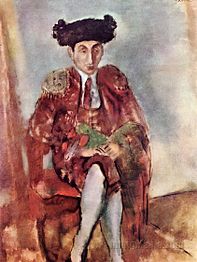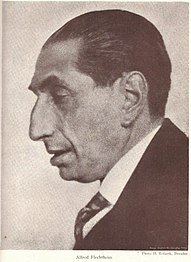Alfred Flechtheim
Alfred Flechtheim | |
|---|---|
 Photograph by Jacob Hilsdorf (1910) | |
| Born | 1 April 1878 |
| Died | 9 March 1937 (aged 58) London, England |
| Occupation | Art dealer |
| Spouse |
Betty Goldschmidt (m. 1910) |
Alfred Flechtheim (1 April 1878 – 9 March 1937) was a German Jewish art dealer, art collector, journalist and publisher persecuted by the Nazis.
Early years
Flechtheim was born into a Jewish merchant family; his father, Emil Flechtheim, was a grain dealer. Alfred became a partner in his father's company after business internships in London and Paris.[1]
Art collector
Flechtheim appeared in the art world shortly after 1900, with a collection of paintings by Vincent van Gogh, Paul Cézanne; French Avant garde early works of Pablo Picasso, Georges Braque and André Derain; paintings of Wassily Kandinsky, Maurice de Vlaminck, Alexej von Jawlensky, Gabriele Münter, and the Rhein Expressionists Heinrich Campendonk, August Macke, Heinrich Nauen, and Paul Adolf Seehaus.
1912 Sonderbund in Cologne
Flechtheim organised The 'Internationale Kunstausstellung des Sonderbunds Westdeutscher Kunstfreunde und Künstler'[2] that opened in Cologne on 25 May 1912. Known as the Sonderbund, the exhibition brought together all avant-garde groups of artists and art movements in Europe (Expressionism, The Brücke, The Blauer Reiter, Fauvism, Cubism) for the first time. Flechtheim was the chairman of the steering committee and the lender of many important artworks by Picasso and other artists[3][4]
Art Dealer
Flechtheim opened his first gallery in Düsseldorf in 1913, followed by galleries in Berlin, Frankfurt, Cologne, and Vienna.[5] Flechtheim served in the German Army during World War I, but not at the front. His art business collapsed during the war but he re-opened in Düsseldorf in 1919.[6] Legendary, glamorous parties in Flechtheim's gallery overflowed with the glitterati of the new Berlin: movie stars, titans of finance, prizefighters and artists of every stripe.[7]
He founded the important modernist art journal Der Querschnitt (The Cross Section) which ran from 1921 until 1936.[8]
Flechtheim, Nazis and Aryanization
As soon as the Nazis came into power, in 1933, Flechtheim was persecuted and his business attacked.
Emigration and death
Six months after the Nazis came to power in 1933, Flechtheim, penniless, fled to Paris, and tried to find work with his former business partner,
Personal life
Flechtheim married
Professor
Recovery of artworks
Flechtheim's heirs are attempting to recover artworks stolen from Flechtheim. These works reside in German museums and American museums, including the Museum of Modern Art.[19]
In 2014 the Museum Ludwig in Cologne restituted Oskar Kokoschka's “Portrait of Tilla Durieux” (1910) to the Flechtheim heirs after a long investigation.[20]
Ernst Ludwig Kirchner's "Das Soldatenbad" (1915) remained in the custody of Flechtheim's niece Rosi Hulisch in Berlin. It was acquired in 1938 by Kurt Feldhäusser, a member of the Nazi party. Upon Feldhäusser's death in 1945, the ownership of his collection passed to his mother, who brought the work to the United States and consigned it to the
Oskar Kokoschka's "Joseph de Montesquiou-Fezensac" (1910) was sold by Alex Vömel to the National Museum of Fine Arts in Stockholm where it would later be transferred to the Moderna Museet. It remained in the Moderna Museet's collection until 2018, when it was restituted to Flechtheim's heirs. In November 2018, it sold at Sotheby's for $20,395,200 (including fees).[21]
Gallery
-
Portrait of Alfred Flechtheim by Hanns Bolz (1885-1918)
-
Alfred Flechtheim dressed as a toreador by Jules Pascin, 1927
-
Portrait of Alfred Flechtheim by Hugo Erfurth, 1928
-
As painted in 1913 by Swedish painterNils Dardel(1888-1943)
See also
References
- ISBN 0-8240-3931-9.
- ^ "Alfred Flechtheim". alfredflechtheim.com. Retrieved 2021-04-15.
In 1912 he organised the pioneering Sonderbund Exhibition in Cologne to which he also loaned works.
- ^ "Alfred Flechtheim –THE SONDERBUND". alfredflechtheim.com. Retrieved 2021-04-15.
- ^ "Internationale Kunstausstellung des Sonderbundes Westdeutscher Kunstfreunde und Kunstler zu Coeln 1912". 1912.
- ^ Michael Sontheimer (25 June 2012). "Stärker als Spiel, Alkohol und Weiber". Der Spiegel (in German). No. 26/2012.
- ^ Malcolm Gee, 'The Berlin Art World, 1918-1933' in: Malcolm Gee, Tim Kirk and Jill Steward (eds), The City in central Europe : culture and society from 1800 to the present, Ashgate, 1999.
- ISBN 978-3-907142-62-2.
- ^ ""Der Querschnitt"". Retrieved 3 June 2020.
- ^ "Exh.: Alfred Flechtheim. Modernism's Art Dealer, Berlin, May-Sept 2017". The International Art Market Studies Association. 2017-05-24. Retrieved 2021-04-15.
- ^ "Two Expressionist Masterworks Restituted to the Heirs of Collector, Dealer and Bon Vivant Alfred Flechtheim". Sothebys. Oct 29, 2018. Archived from the original on 2020-09-23.
The Nazis came to power at the beginning of 1933 and destroyed Alfred's life and business almost overnight. His Jewish faith, his flamboyant reputation and his ardent support of the avant-garde exposed him to unparalleled persecution.
- ^ a b c d Cohan, William D. (17 November 2011). "MoMA's Problematic Provenances". ARTnews. Archived from the original on Nov 18, 2019.
- ISBN 0-7864-4092-9.
- ^ "The unfinished art business of World War Two". BBC News. 2013-11-04. Retrieved 2021-04-15.
- ^ Kaplan, Isaac (2016-12-07). "Heirs of Major Jewish Art Dealer Sue Bavaria over $20 Million of Nazi-Looted Art". Artsy. Retrieved 2021-04-15.
- ^ "Selected Dealer Archives & Locations (Getty Research Institute)". www.getty.edu. Retrieved 2021-04-15.
- ISBN 9783110404845, retrieved 2022-01-25
- ^ "Alfred Flechtheim – Liquidation". alfredflechtheim.com.
- ^ Koldehoff, Stefan (30 June 2010). "Mit deutschen Grüßen". Die Welt (in German).
- ^ Burleigh, Nina (2012). "Haunting MoMA: The Forgotten Story of 'Degenerate' Dealer Alfred Flechtheim". Gallerist New York. Archived from the original on 2014-01-09. Retrieved 2012-07-03.
- ^ "Cologne Returns Nazi-Looted Kokoschka Portrait of Tilla Durieux". lootedart.com. Artinfo. 19 June 2013. Retrieved 2023-10-31.
After over four years of investigation, the Cologne City Council unanimously decided to offer the return of the painting to Flechtheim's family on April 30, 2013.
- ^ "OSKAR KOKOSCHKA | Joseph de Montesquiou-Fezensac". Sothebys.
External links
- Alfred Flechtheim: Art Dealer of the AvantGarde
- The Devil and the Art Dealer
- "Haunting MoMA: The Forgotten Story of 'Degenerate' Dealer Alfred Flechtheim", Observer, by Nina Burleigh, 2012
- Artworks Stolen From Alfred Flechtheim at the MOMA
- Internationale Kunstausstellung des Sonderbundes Westdeutscher Kunstfreunde und Kunstler zu Coeln 1912




